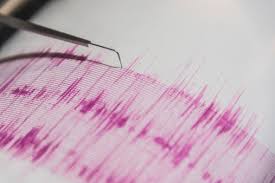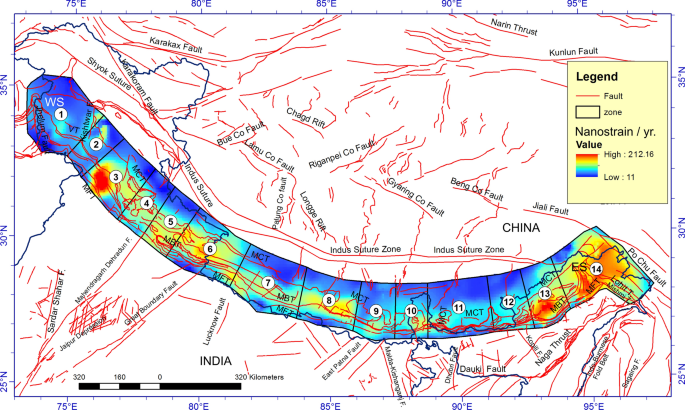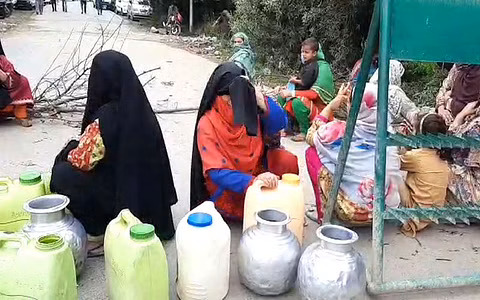A moderate-intensity earthquake jolted the Kashmir valley in the middle of the night but caused no damage or casualties in the region.
 An official of the state Meteorological Department said the tremor was of 5.8 magnitude and its epicentre was located at a depth of 220 km in the Hindu Kush region of Afghanistan. The earthquake was recorded at 1.34 am on Tuesday night, the official said.
An official of the state Meteorological Department said the tremor was of 5.8 magnitude and its epicentre was located at a depth of 220 km in the Hindu Kush region of Afghanistan. The earthquake was recorded at 1.34 am on Tuesday night, the official said.
It was the sixth tremor to jolt the Kashmir region in the past one month and seventh since October last year. There were, however, no immediate reports of any damage or injuries caused by the tremor.
Earlier, the region was jolted by a tremor on Friday last week which had a magnitude of 5.5. The January 2 earthquake had a magnitude of 5.8.
Last month, the Kashmir region was jolted by three tremors of magnitude 4.7, 6.5 and 7. On October 27 last year, a 7.5-magnitude earthquake had rattled the Kashmir valley. All tremors had their epicentre in the Hindu Kush region of Afghanistan.
Shakil Ahmad Romshoo, head of the Earth Sciences Department at the University of Kashmir, said the tremors in recent months were not worrisome for Kashmir as the epicentre was located at a distance from the region.
“If something happens in the Valley, it should really be a worry. The fact is that we are vulnerable to earthquakes and there is no doubt about that,” Romshoo said.
“We are vulnerable, but there is no exact prediction science about earthquakes so we cannot say how much pressure is there, where it will rupture,” Romshoo said, adding there is a need to create awareness and make preparations.
Romshoo said the Department of Earth Sciences would soon start work on a three-year research programme to assess the seismic vulnerability of Srinagar city. The programme, likely to begin in March, will study and categorise the seismic vulnerability of the city.
“There are 65 municipal wards in Srinagar city. We will tell exactly which ward is how much vulnerable to earthquakes and then we will categorise them so that the government can take measures accordingly,” Romshoo said.
An association of doctors in the region has already sounded an alarm at the lack of preparedness in hospitals in the region to deal with mass casualties during a major earthquake.
Tectonically active Jammu and Kashmir has remained ‘most susceptible’ to big earthquakes as nearly 50 of them, including three tremors this year alone, have been reported in the state since 2014.
The state lies in Seismic Zone IV and V. Seismologists and geologists believe that the state is prone to “most destructive” earthquakes (with magnitude above 8 on the Richter scale), leading to “immeasurable disaster”.
“There have been 50 earthquakes in Jammu and Kashmir since January 2014. Of them, 40 were felt by the people in the state. During the period, the biggest quake had a magnitude of 7.5 on the Richter scale and was reported on October 26 last year,” said Farooq Ahmed Bhat, in charge, Seismology Wing, Indian Meteorological Department (IMD).
Bhat said at least 28 earthquakes were reported in Jammu and Kashmir last year, of which 19 shocks were felt and noted by the observatory at the IMD Centre in the Kashmir valley. “We have recorded three tremors in January this year and all have been felt in the state. The three tremors having magnitude of 5.8, 5.5 and 5.8 were noticed on January 2, 8 and 13, respectively. They had their epicentre in the Hindu Kush region of Afghanistan,” he said.
In 2014, Bhat said 18 of the 19 tremors were felt in Jammu and Kashmir. “The intensity of the biggest tremor was 6.8 on the Richter scale on February 12, 2014,” he said.
“As the epicentre of a majority of tremors jolting J&K remains the Hindu Kush region of Afghanistan, the intensity is generally low. The highest-intensity tremor in the history of J&K was 8 on the Richter scale on April 4, 1905, followed by a 7.8-magnitude earthquake on October 8, 2005, which had its epicentre in Muzaffarabad near the Line of Control (LoC), killing nearly 80,000 people on both sides of the LoC,” the seismologist said.
He, however, described the frequent tremors in the state as a “routine activity” as J&K falls in the high seismic zone. “We cannot predict earthquakes. There is a need for good scientific and holistic planning to deal with this danger,” he said.
GM Bhat, noted geologist of the state, had earlier told that the “threat perception” regarding massive earthquakes was high in Jammu and Kashmir and there was a need for immediate attention to deal with the situation.
“So far, the efforts and preparedness to deal with such disasters in the state are not satisfactory. Any earthquake with a magnitude above 8 will cause immeasurable disaster in the state,” Bhat had said.
Referring to the research of CIRES Fellow Roger Bilham, Bhat had said: “It had been predicted that if a 9 earthquake was to occur in Kashmir, he (Bilham) estimates the rupture would extend from the 2005 earthquake zone near Muzaffarabad, Pakistan, to Kangra, 1905 earthquake zone in Himachal Pradesh, a distance of about 480 km, and from the Zanskar range to south of the Pir Panjal range (Rajouri), a distance of about 190 km.”






